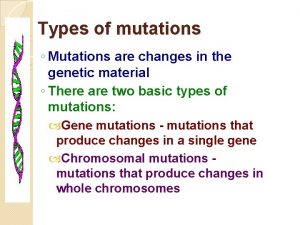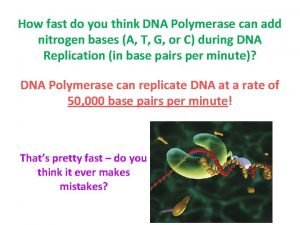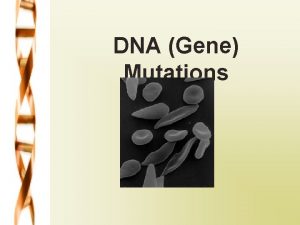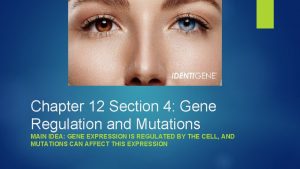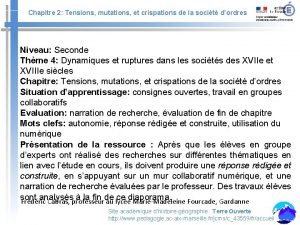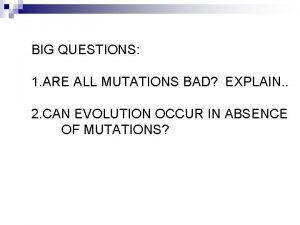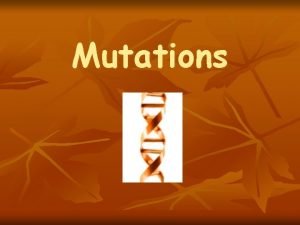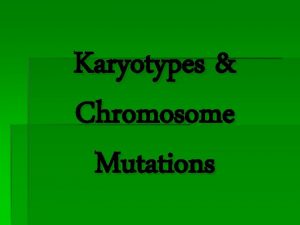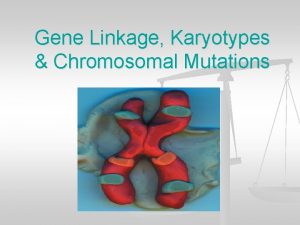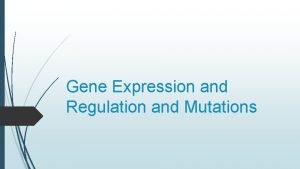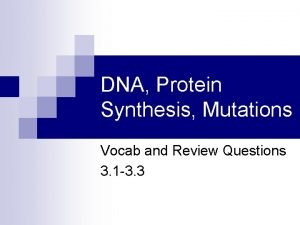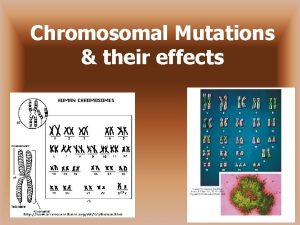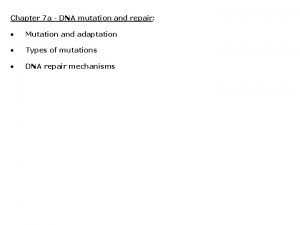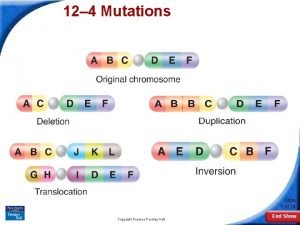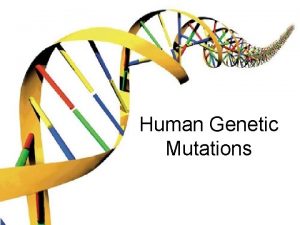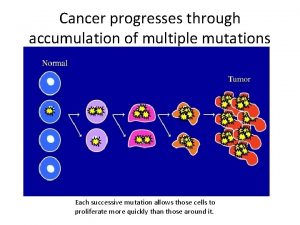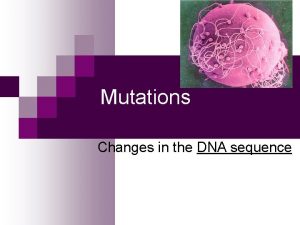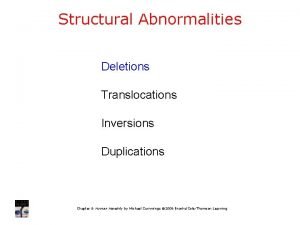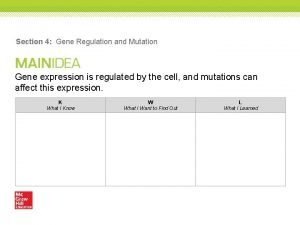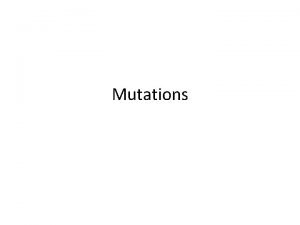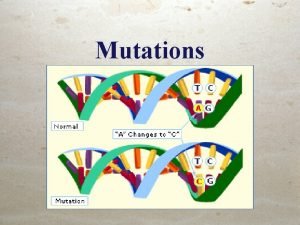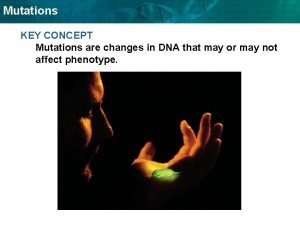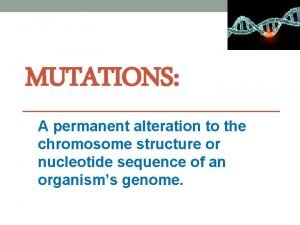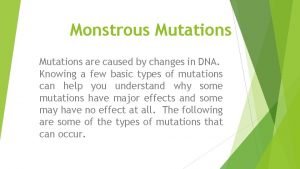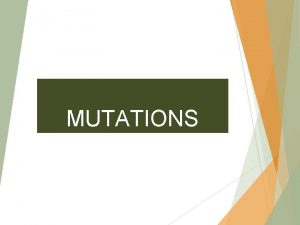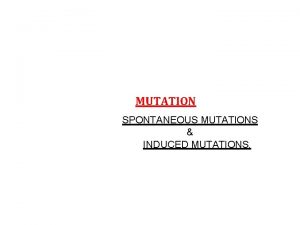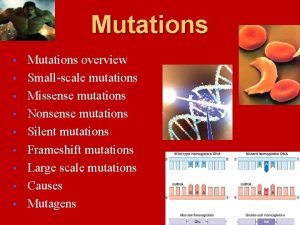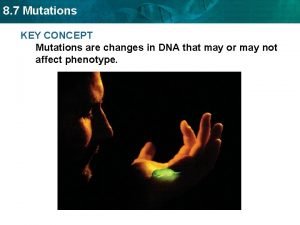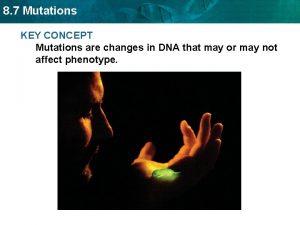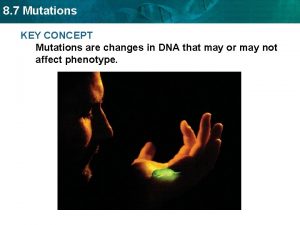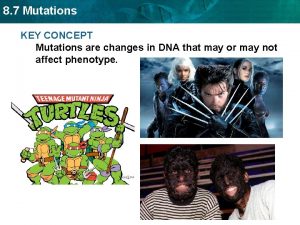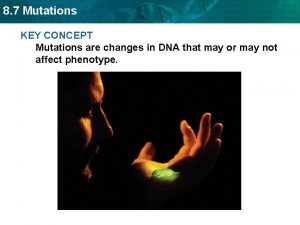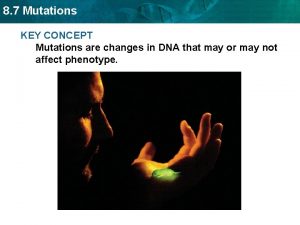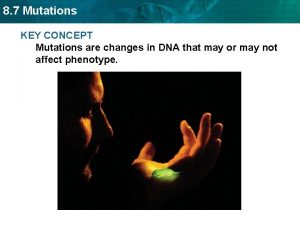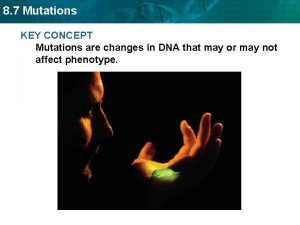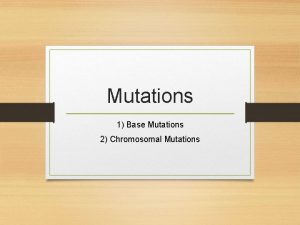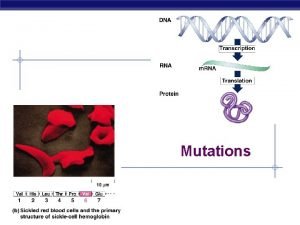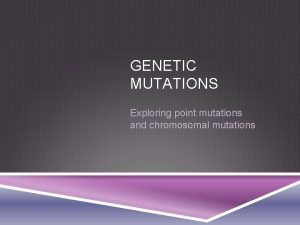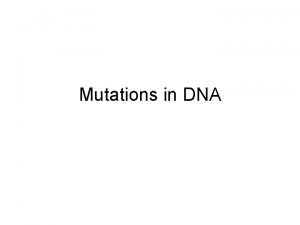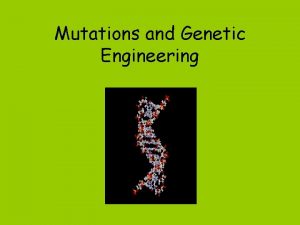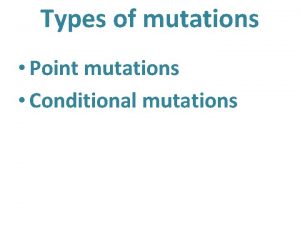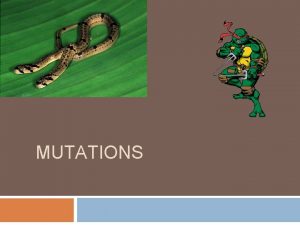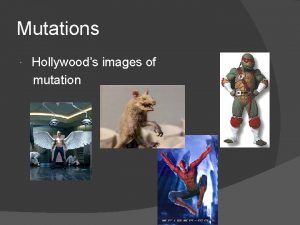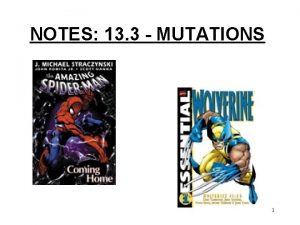MUTATIONS WHAT ARE MUTATIONS KEY CONCEPT Mutations are






































- Slides: 38

MUTATIONS

WHAT ARE MUTATIONS? KEY CONCEPT: Mutations are changes in genetic material. VOCABULARY: Mutation, point mutation, frameshift mutation, polyploidy

What happens when a protein malfunctions? If a protein can't do its job, then cells containing that protein may not function properly. Since humans are composed of cells, a malfunction may lead to medical problems.

HOW DO MUTATIONS HAPPEN? There are two ways in which DNA can become mutated: 1. Mutations can be inherited. This means that if a parent has a mutation in his or her DNA, then the mutation is passed on to his or her children. 2. Mutations can be acquired. This happens when environmental agents damage DNA, or when mistakes occur when a cell copies its DNA prior to cell division.

Here's another way to think about it! Think of a cell as a car. A car is made up of many parts, just as a cell is made up of many proteins. Each part -- or protein -- does a specific job.

ANALOGY What happens when a part breaks on your car? It depends! If one headlight burns out, you can still drive the car, although driving at night may be tough.

ANALOGY Proteins in cells work the same way. Some proteins are more important to a cell's normal function than others. A cell might still be able to function properly if the mutated protein isn't that important, like the headlight on your car.

ANALOGY But when your brakes fail, you're really in trouble -- before you know it, your car is cruising out of control! And if you're driving in traffic when this happens, then your car troubles are certain to affect the cars around you, making problems for the whole street.

KINDS OF MUTATIONS 1. MICROMUTATIONS: Gene mutations result from changes in a single gene.

KINDS OF MUTATIONS 2. MACROMUTATIONS: Chromosomal mutations involve changes in whole chromosomes.

MICROMUTATIONS OR GENE MUTATIONS Point Mutations Affect one nucleotide Occur at a single point in the gene sequence Three Types: Substitution 2. Insertion 3. Deletion 1.

Point Mutations Substitution A single nucleotide is changed in the nucleotide sequence. This may result in a change to a single amino acid in the protein. The change to a single amino acid may or may not alter the proteins function.

Point Mutations - Substitution Codon UGU UGC UGG UGA = Amino Acid Original Cysteine No Change Cysteine Single AA Tryptophan Bad STOP

GENE MUTATION: SUBSTITUTION DNA: TAC GCA m. RNA: AUG CGU TGG ATT ACC UUA Amino Acid: MET ARG THR LEU Substitution DNA: m. RNA: Amino Acid: TAC GTA AUG CGU MET HIS TGG ACC ATT UUA THR LEU

Substitution Mutations 3’AGTTCAG-TAC-TGA-ACA-CCA-TCA-ACT-GATCATC 5’ 5’AGUC-AUG-ACU-UGU-GGU-AGU-UGA-CUAGAAA 3’ Transition Met Thr Cys Gly Ser 3’AGTTCAG-TAC-TGA-ATA-CCA-TCA-ACT-GATCATC 5’ 5’AGUC-AUG-ACU-UAU-GGU-AGU-UGA-CUAGAAA 3’ Met Thr Tyr Gly Ser Pyrimidine to Pyrimidine 3’AGTTCAG-TAC-TGA-ACA-CCA-TCA-ACT-GATCATC 5’ 5’AGUC-AUG-ACU-UGU-GGU-AGU-UGA-CUAGAAA 3’ Transversion Met Thr Cys Gly Ser 3’AGTTCAG-TAC-TGA-AAA-CCA-TCA-ACT-GATCATC 5’ 5’AGUC-AUG-ACU-UUU-GGU-AGU-UGA-CUAGAAA 3’ Met Thr Phe Gly Ser Purine to Pyrimidine

Point Mutations Frameshift Mutations Result From Insertions & Deletions A nucleotide is added, or subtracted from the nucleotide sequence. This shifts the Codon grouping and drastically alters the amino acid sequence in the protein.

GENE MUTATION: INSERTION DNA: TAC GCA m. RNA: AUG CGU TGG ATT ACC UUA Amino Acid: MET ARG THR LEU Insertion DNA: m. RNA: Amino Acid: TAT CGC AUA GCG ILE ALA ATG UAC TRY GAA T CUU A LEU

GENE MUTATION: DELETION THE FAT CAT ATE THE RAT Deletion THE F AT C TEF ATC AT A TE T ATA TET HE R HER AT AT The loss of a single DNA base can change the entire message that DNA sends to make a protein! DIFFERENT DNA MESSAGE = DIFFERENT PROTEIN

Frame Shift Mutations 3’AGTTCAG-TAC-TGA-ACA-CCA-TCA-ACT-GATCATC 5’ 5’AGUC-AUG-ACU-UGU-GGU-AGU-UGA-CUAGAAA 3’ Met Thr Cys Gly Ser 3’AGTTCAG-TAC-TGA-AAC-CAT-CAA-CTG-ATCATC 5’ 5’AGUC-AUG-ACU-UUG-GUA-GUU-GAC-UAG-AAA 3’ Met Thr Leu Val Val Frame shift mutations tend to have a dramatic effect on proteins as all codons down stream from the mutation are changed and thus code for different amino acids. As a result of the frame shift, the length of the polypeptide may also be changed as a stop codon will probably come at a different spot than the original stop codon.

MACROMUTATIONS: CHROMOSOMAL MUTATIONS Changes the number or structure of chromosomes As a result the locations of genes on chromosome or the number of copies of some genes may change.

MACROMUATIONS: CHROMOSOMAL MUTATIONS 1 Deletions - Loss of chromosome sections 2 Duplications - Duplication of chromosome sections 3 Inversions - Flipping of parts of chromosomes 4 Translocations - Movement of one part of a chromosome to another part

MACROMUTATION: DELETION X Deletion Loss of all or part of a chromosome

MACROMUTATION: DELETION Centromere A A B B C C Original chromosome Genes D D E G F H G H New Chromosome E F

MACROMUTATION DUPLICATION Duplication Segment of chromosome is repeated

MACROMUTATION: DUPLICATION Centromere A B C Original chromosome Genes D E F G H New Chromosome A B C D E F Duplication G H

MACROMUTATION: INVERSION Inversion Chromosome or part of a chromosome is placed in the reverse direction

MACROMUATION: INVERSION Centromere A B C Original chromosome Genes D E F G H New chromosome A B C D F E Inversion G H

MACROMUTATION: TRANSLOCATION Translocation Part of one chromosome breaks off and attaches to another chromosome

MACROMUTATION: TRANSLOCATION Centromere A B Original Chromosome Genes C D E F G H New chromosome A B E F C D G H

SIGNIFICANCE OF MUTATIONS Most mutations are NEUTRAL— they have little or no effect on genes or the function of proteins. We all have mutations within our DNA

HARMFUL MUTATIONS Mutations can cause a dramatic changes in the protein structure are often HARMFUL. THESE DEFECTIVE PROTEINS CAN DISRUPT NORMAL BIOLOGICAL ACTIVITIES. Harmful mutations are associated with many types of cancer.

BENEFICIAL MUTATIONS Mutations are also the source of GENETIC VARIATION in a species. Beneficial mutations may produce proteins with new or altered activities that can be useful to organisms in different or changing environments.

BENEFICIAL MUTATIONS POLYPLOIDY: organism has extra sets of chromosomes When a complete set of chromosomes fail to separate during meiosis, the gametes that result may produce TRIPLOID (3 N) or TETRAPLOID (4 N) organisms.

BENEFICIAL MUTATIONS Polyploid plants are often larger and stronger than diploid plants. Important crop plants have been produced in this way. Example: bananas, citrus fruits, seedless plants

INHERITED MUTATIONS DNA fails to copy accurately Most of the mutations that we think matter to evolution are "naturally-occurring. " For example, when a cell divides, it makes a copy of its DNA — and sometimes the copy is not quite perfect. That small difference from the original DNA sequence is a mutation.

INHERITED MUTATIONS

EXTERNAL INFLUENCES CAUSE MUTATIONS Mutations can be caused by exposure to specific chemicals or radiation. These agents cause the DNA to break down.

EXTERNAL INFLUENCES CAUSE MUTATIONS This is not necessarily unnatural — even in the most isolated and pristine environments, DNA breaks down. Nevertheless, when the cell repairs the DNA, it might not do a perfect job of the repair. So the cell would end up with DNA slightly different than the original DNA and hence, a mutation.
 Insidan region jh
Insidan region jh Chapter 4 lesson 4 metamorphic rocks answer key
Chapter 4 lesson 4 metamorphic rocks answer key Lesson 1 introduction to waves
Lesson 1 introduction to waves Key partners canvas
Key partners canvas Contoh bisnis model canvas makanan pdf
Contoh bisnis model canvas makanan pdf Compare actual self and ideal self
Compare actual self and ideal self Pengertian pemasaran
Pengertian pemasaran Types of mutations
Types of mutations What are some neutral mutations
What are some neutral mutations Dna vs rna worksheet answer key
Dna vs rna worksheet answer key What are causes of mutation
What are causes of mutation Chapter 14 lesson 4 mutations
Chapter 14 lesson 4 mutations Section 4 gene regulation and mutation
Section 4 gene regulation and mutation Tensions mutations et crispations de la société d'ordres
Tensions mutations et crispations de la société d'ordres Are all mutations bad? explain
Are all mutations bad? explain What is a beneficial mutation in humans
What is a beneficial mutation in humans Missense mutation in sickle cell anemia
Missense mutation in sickle cell anemia Slidetodoc.com
Slidetodoc.com Chromosomal mutation
Chromosomal mutation Types of mutations
Types of mutations Protein synthesis and mutations
Protein synthesis and mutations Protein synthesis and mutations
Protein synthesis and mutations Karyotype mutations
Karyotype mutations Mutation and adaptation
Mutation and adaptation 12-4 mutations
12-4 mutations Cancer mutations
Cancer mutations 2 main types of mutations
2 main types of mutations Cancer mutations
Cancer mutations Cancer mutations
Cancer mutations Dna types of mutations
Dna types of mutations Mutation reverse
Mutation reverse Mutations translocation
Mutations translocation Section 4 gene regulation and mutation
Section 4 gene regulation and mutation Chromosome mutation
Chromosome mutation Chromosomal mutation
Chromosomal mutation Gene mutations
Gene mutations Chromosomal mutations
Chromosomal mutations Monstrous mutations
Monstrous mutations Types of mutations
Types of mutations







